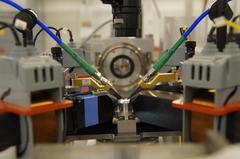URL: https://www.desy.de/news/news_search/index_eng.html
Breadcrumb Navigation
DESY News: Quantum beats for zeptosecond timing
News
News from the DESY research centre
Quantum beats for zeptosecond timing
Quantum systems will be crucial to future technologies. However, in order to use such systems in practical applications, it is necessary to control and manipulate them with great precision. A Hamburg research team has now succeeded in controlling and measuring a quantum system with hitherto unattainable temporal precision on the PETRA III beamline P01. They managed to control and detect oscillations inside an atomic nucleus, as well as the gamma radiation emitted, to within 1.3 zeptoseconds. A zeptosecond is 0.000 000 000 000 000 000 001 seconds; the thousandth part of a billionth of a billionth of a second. The new method developed by the team makes use of the fundamental excitations that occur within a solid. Precise adjustments of this kind are important when building quantum sensors, for example, to establish extremely precise time standards or to detect minute changes. The newly developed method may also have potential applications in quantum computers or quantum communication, as a way of making specific adjustments to such systems.

View of the experiment at the PETRA III beamline P01 (in X-ray beam direction): The sample on the round table in the centre of the picture is connected to microwave measuring tips. The X-rays emitted by the sample are analysed at the end with a detector. Electromagnets with iron yokes around the sample table generate a magnetic field at the sample location to align the magnetisation in the sample (photo: L. Bocklage/DESY).
In order to measure such small changes in the first place, the scientists resorted to a trick: they looked at not one, but two different resonances of the atomic nucleus, which emit gamma radiation of slightly different frequencies. When both resonances of the atomic nucleus are excited, beating occurs, in other words the intensity of the emitted gamma radiation fluctuates. Beats occur when two oscillations of slightly different frequencies are superimposed on each other. This results in a periodic increase and decrease in amplitude, i.e. the size of the oscillations. For example, when two sounds of almost the same frequency are played together, the volume appears to rise and fall. The closer the frequencies of the individual notes, the slower this change in volume. The change in volume can be used to deduce how close the frequencies of the two notes are to each other. In this experiment, the beats are purely quantum mechanical, a “quantum beat”. This quantum beat is extremely sensitive to minute time changes in the atomic nucleus. However, the beat itself does not occur on the timescale of zeptoseconds; it varies over a period of nanoseconds and can thus be measured using high-speed photodetectors.

The experiments mark a first step towards using this novel method of controlling an embedded quantum system by exciting the surrounding solid. Apart from magnon excitation, a number of other solid-state excitations exist, which the group now intends to test, such as oscillations of the crystal lattice or the electrons. The method could also be applied to quantum systems that are already being considered for quantum computers, such as nitrogen vacancy centres in diamonds or ion-doped solids.
Reference
Coherent control of collective nuclear quantum states via transient magnons; Lars Bocklage, Jakob Gollwitzer, Cornelius Strohm, Christian F. Adolff, Kai Schlage, Ilya Sergeev, Olaf Leupold, Hans-Christian Wille, Guido Meier and Ralf Röhlsberger, Science Advances 29 Jan 2021: Vol. 7, no. 5, eabc3991; DOI: 10.1126/sciadv.abc3991



